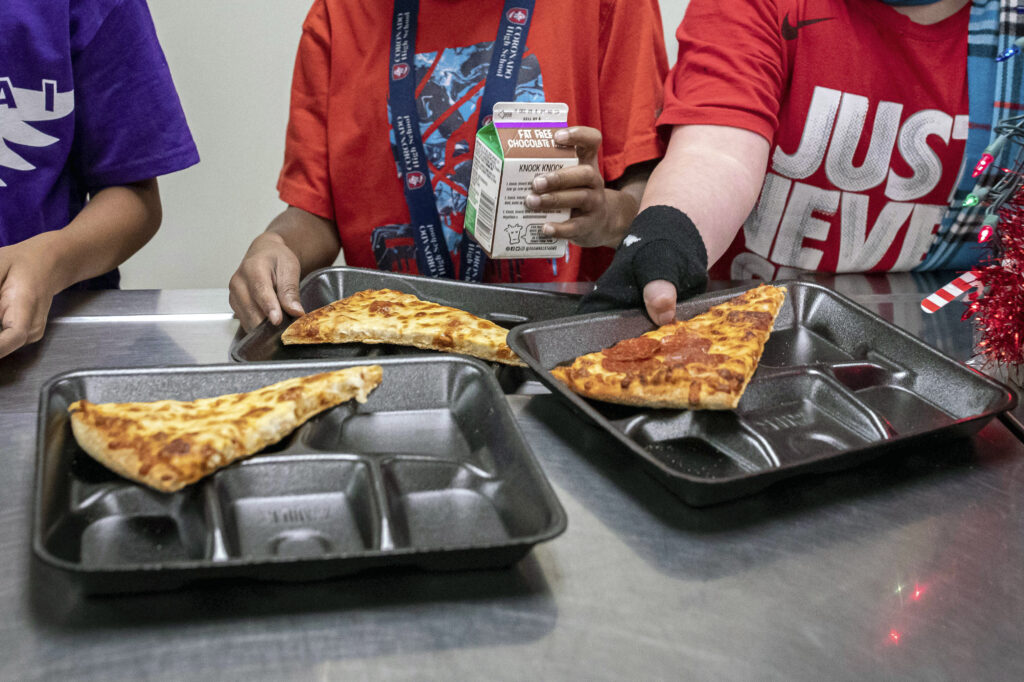🔴 Website 👉 https://u-s-news.com/
Telegram 👉 https://t.me/usnewscom_channel
An estimated 530,000 tons of food and 45 million gallons of milk are wasted in our nation’s school cafeterias annually — 31% of vegetables and 25% of milk purchased.
Taxpayers lay out $1.7 billion at the front end to buy and cook this squandered food, and more on the back end to truck it to landfills.
Blame it on our federal school lunch regulations.
I lead a network of 57 charter schools serving 22,000 students. At a school we’re building in The Bronx, we’re creating a restaurant-quality kitchen so we can cook high-quality food from scratch.
However, Washington’s many inane and wasteful requirements make that aim virtually impossible.
For example, we must serve fruits and vegetables to students who refuse to eat them.
Even if it’s the last day of school and a child has thrown out his apple for 179 days in a row, we have to give him another one.
But the biggest problem with federal school-lunch rules is their mind-blowing complexity.
The regulations run 47,920 words — nearly seven times that of the Constitution and all 27 amendments combined.
I’d like to hire a cook who can make affordable, healthy meals like roast chicken, scalloped potatoes and hearty soups, someone who keeps costs down by throwing leftover vegetables into a stew and using what’s in season or on sale.
But the regulations prohibit any such improvisation.
They require us to use standardized recipes, tested to ensure they meet federal requirements, and to follow them religiously.
The rules are so complicated that any cook I hire would also need a law degree.
They specify five different categories of vegetables: dark green; red/orange; beans, peas and lentils; starch, and other. We must use minimum amounts of each of these five subgroups every week.
And not equal amounts, mind you. That would be too easy.
We must serve ¾ cups per week of red/orange vegetables but only ½ cup of dark green ones.
Unless the dark green vegetables are leafy greens, in which case you need a full cup.
And don’t make the mistake of thinking that bean sprouts, Brussels sprouts, green beans and green peppers count as dark green vegetables. For some reason they don’t, although mesclun, romaine and watercress do.
And suppose our cooks want to offer a vegetarian alternative to the meat requirement. No problem!
They just need to make sure it meets 2,563 words’ worth of requirements, including gems like this: “Each 100 grams of the product (on a 13% moisture basis) must contain protein in amounts which is equivalent to that provided by 20 grams of protein with a quality of not less than 95% casein. The equivalent grams of protein required per 100 grams of product (on a 13% moisture basis) would be determined by the following equation: x=ab/c.”
All these rules are so complex that only a large corporation can master them.
The bureaucrats also impose unnecessary bookkeeping burdens on schools, forcing us to record not only exactly how many lunches we serve each day, but which students eat.
The program could simply reimburse schools based on the number of students eligible for free and reduced-price lunch, and just use attendance records to figure out how many missed lunch due to absence.
Instead, the federal government requires states to maintain a bevy of bureaucrats to make us follow their rules — and then employs its own bureaucrats to police the state bureaucrats.
Up and down the line, from DC to the local school kitchen, the program forces vast resources to be spent on compliance that could go toward buying good ingredients and paying good cooks.
The problem here isn’t just the government’s onerous rules, but the very idea that school lunch should be federally regulated at all.
Congress passed the School Lunch Act in 1946 because the military found during World War II that recruits who had grown up during the Depression weren’t fit for service due to childhood malnourishment.
Things have changed since then. Nutrition is still important, but it’s not a national security issue.
The federal government has plenty of work that only it can do: fighting terrorism, regulating the stock market, approving pharmaceuticals and more.
Figuring out how to feed our children nutritious meals is something that can and should be left to local communities — or better yet, to the schools themselves.
But once a federal program has been established, the people who run it find it impossible to imagine that their jobs shouldn’t exist.
I don’t blame them. It’s human nature.
But that’s why it’s so refreshing to see a new president bring in outsiders from the private sector to take a hard look at where government can be pared away.
The school lunch bureaucracy is a good place to start.
Eva Moskowitz is the founder and CEO of Success Academy Charter Schools.
